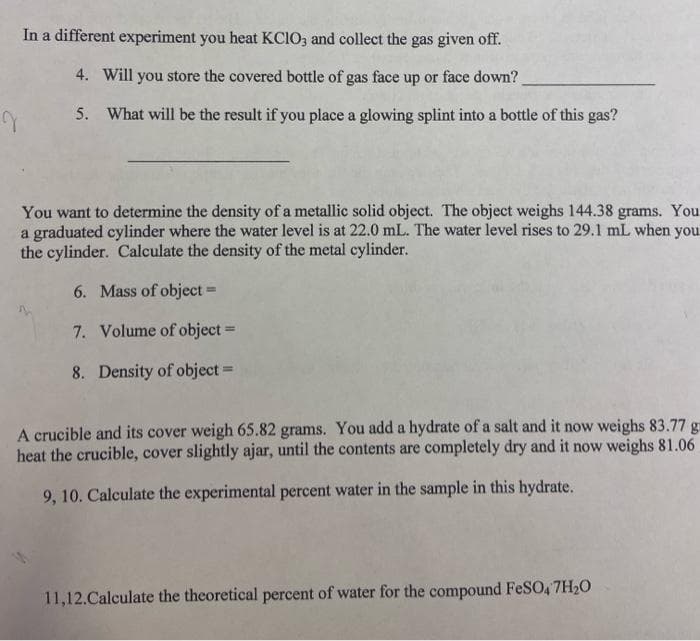In a different experiment you heat KCIO3 and collect the gas given off. 4. Will you store the covered bottle of gas face up or face down? 5. What will be the result if you place a glowing splint into a bottle of this gas?
In a different experiment you heat KCIO3 and collect the gas given off. 4. Will you store the covered bottle of gas face up or face down? 5. What will be the result if you place a glowing splint into a bottle of this gas?
Introductory Chemistry: An Active Learning Approach
6th Edition
ISBN:9781305079250
Author:Mark S. Cracolice, Ed Peters
Publisher:Mark S. Cracolice, Ed Peters
Chapter4: Introduction To Gases
Section: Chapter Questions
Problem 67E: The compression ratio in an automobile engine is the ratio of the gas pressure at the end of the...
Related questions
Question

Transcribed Image Text:In a different experiment you heat KCIO3 and collect the gas given off.
4. Will you store the covered bottle of gas face up or face down?
5. What will be the result if you place a glowing splint into a bottle of this gas?
You want to determine the density of a metallic solid object. The object weighs 144.38 grams. You
a graduated cylinder where the water level is at 22.0 mL. The water level rises to 29.1 mL when you.
the cylinder. Calculate the density of the metal cylinder.
6. Mass of object =
7. Volume of object =
8. Density of object =
A crucible and its cover weigh 65.82 grams. You add a hydrate of a salt and it now weighs 83.77 g
heat the crucible, cover slightly ajar, until the contents are completely dry and it now weighs 81.06
9, 10. Calculate the experimental percent water in the sample in this hydrate.
11,12.Calculate the theoretical percent of water for the compound FeSO, 7H20
Expert Solution
This question has been solved!
Explore an expertly crafted, step-by-step solution for a thorough understanding of key concepts.
This is a popular solution!
Trending now
This is a popular solution!
Step by step
Solved in 2 steps

Knowledge Booster
Learn more about
Need a deep-dive on the concept behind this application? Look no further. Learn more about this topic, chemistry and related others by exploring similar questions and additional content below.Recommended textbooks for you

Introductory Chemistry: An Active Learning Approa…
Chemistry
ISBN:
9781305079250
Author:
Mark S. Cracolice, Ed Peters
Publisher:
Cengage Learning

General Chemistry - Standalone book (MindTap Cour…
Chemistry
ISBN:
9781305580343
Author:
Steven D. Gammon, Ebbing, Darrell Ebbing, Steven D., Darrell; Gammon, Darrell Ebbing; Steven D. Gammon, Darrell D.; Gammon, Ebbing; Steven D. Gammon; Darrell
Publisher:
Cengage Learning

Physical Chemistry
Chemistry
ISBN:
9781133958437
Author:
Ball, David W. (david Warren), BAER, Tomas
Publisher:
Wadsworth Cengage Learning,

Introductory Chemistry: An Active Learning Approa…
Chemistry
ISBN:
9781305079250
Author:
Mark S. Cracolice, Ed Peters
Publisher:
Cengage Learning

General Chemistry - Standalone book (MindTap Cour…
Chemistry
ISBN:
9781305580343
Author:
Steven D. Gammon, Ebbing, Darrell Ebbing, Steven D., Darrell; Gammon, Darrell Ebbing; Steven D. Gammon, Darrell D.; Gammon, Ebbing; Steven D. Gammon; Darrell
Publisher:
Cengage Learning

Physical Chemistry
Chemistry
ISBN:
9781133958437
Author:
Ball, David W. (david Warren), BAER, Tomas
Publisher:
Wadsworth Cengage Learning,

Chemistry: Principles and Practice
Chemistry
ISBN:
9780534420123
Author:
Daniel L. Reger, Scott R. Goode, David W. Ball, Edward Mercer
Publisher:
Cengage Learning

Chemistry: Principles and Reactions
Chemistry
ISBN:
9781305079373
Author:
William L. Masterton, Cecile N. Hurley
Publisher:
Cengage Learning

Introductory Chemistry: A Foundation
Chemistry
ISBN:
9781337399425
Author:
Steven S. Zumdahl, Donald J. DeCoste
Publisher:
Cengage Learning